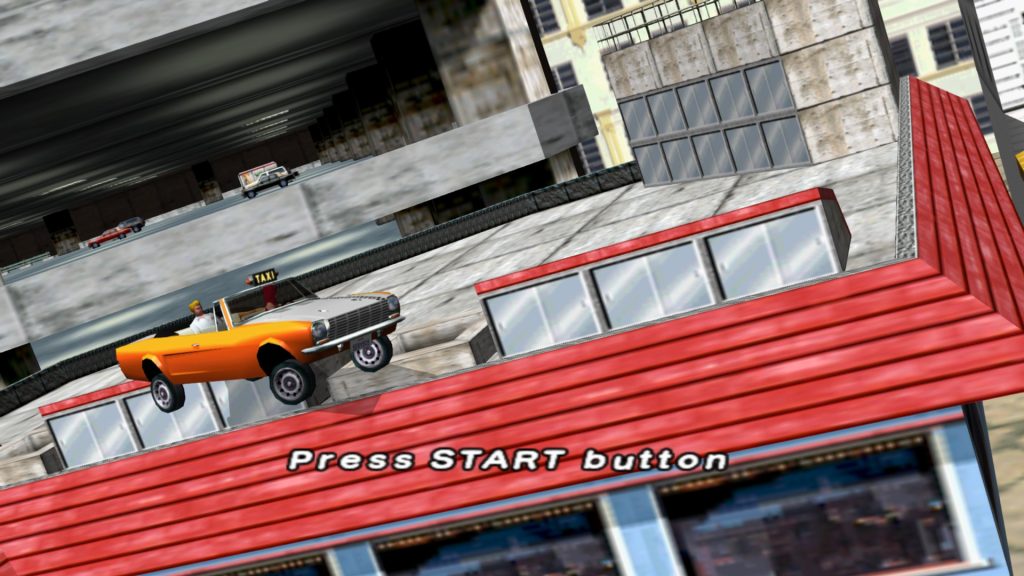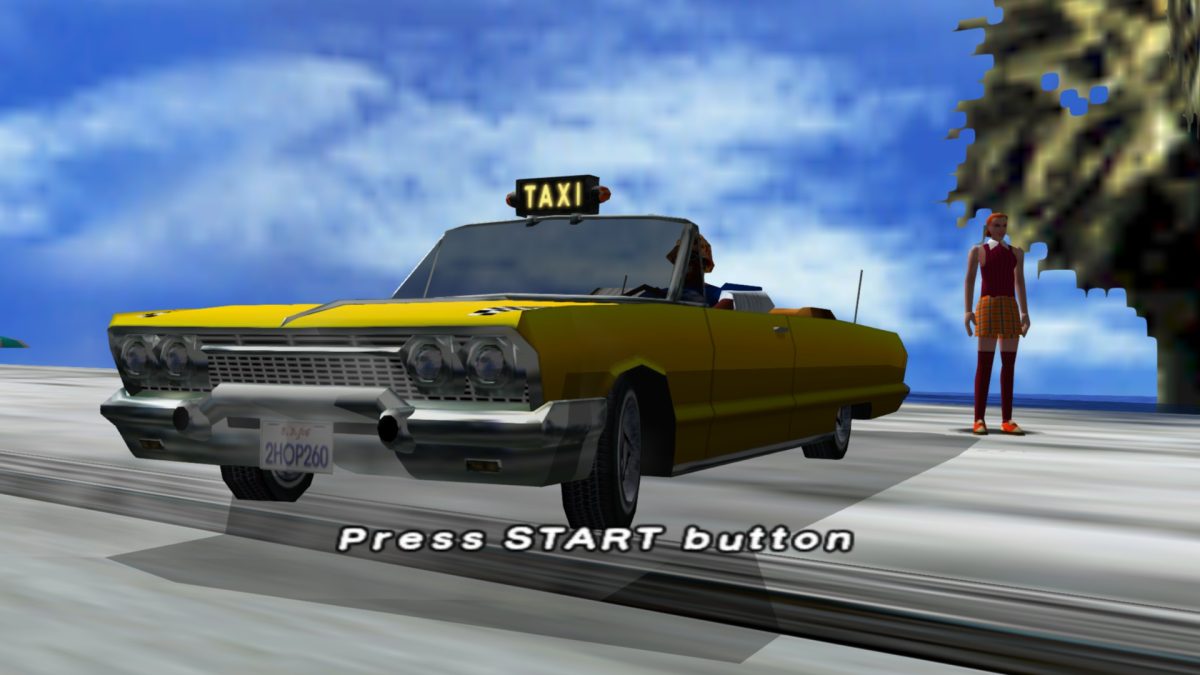So, it’s the weekend, and I’m hanging at my mate’s house. He lives a couple streets away from me; it’s not far, I’m round pretty often. We’re both young, into the later half of our primary school experience, maybe 7 or 8 years old. He seems to have all these cool games. It felt like everyone I knew had more elusive and novel consoles back then – my cousins had an N64 and a PS2, some of my classmates were talking about the new XBox 360 and the PS3. At home, I’ve got, like, the Wii and the DS. And they’re great, I’m not dissing them – but I felt like I was lagging behind everyone else in terms of cool game stuff to own.
That’s why I’m round at my mate’s place so often. He had loads of cool Nintendo stuff that I didn’t – the DSi, all these neat little Wii gadgets, and most relevant to this story, the GameCube. For some reason, it was the GC that stood out to me most. We played Luigi’s Mansion on it, I liked that a lot. And Mario Sunshine, of course, although that never really stuck with me. The unlikely game which won me over on that platform was actually Crazy Taxi.
It was fast paced, it was abstract, and more than anything, it was a clunky mess. I loved it. I used to talk about it all the time when I was younger, and I still have fond nostalgia for it now. I think the appeal of it to me was threefold – it encouraged crashing into stuff, it was set in a quasi-open world, and it had a very unique, very strange atmosphere.

Years later – like, about a decade later – I’m in my first year of uni. I’m doing a BA, so I have a lot of free time to fill, but I’m on a tight budget. So I make the trip to CeX and buy myself a PS2 for about £45. Up until this point, I had never even owned a PlayStation – I’d been more of a PC convert in my mid-teens. I just had the fervent memories of playing Burnout: Revenge at my cousins place whenever I got the chance, wanting to relive that old nostalgia. I thought it was worth buying anyways since resale PS2 games are dirt cheap.
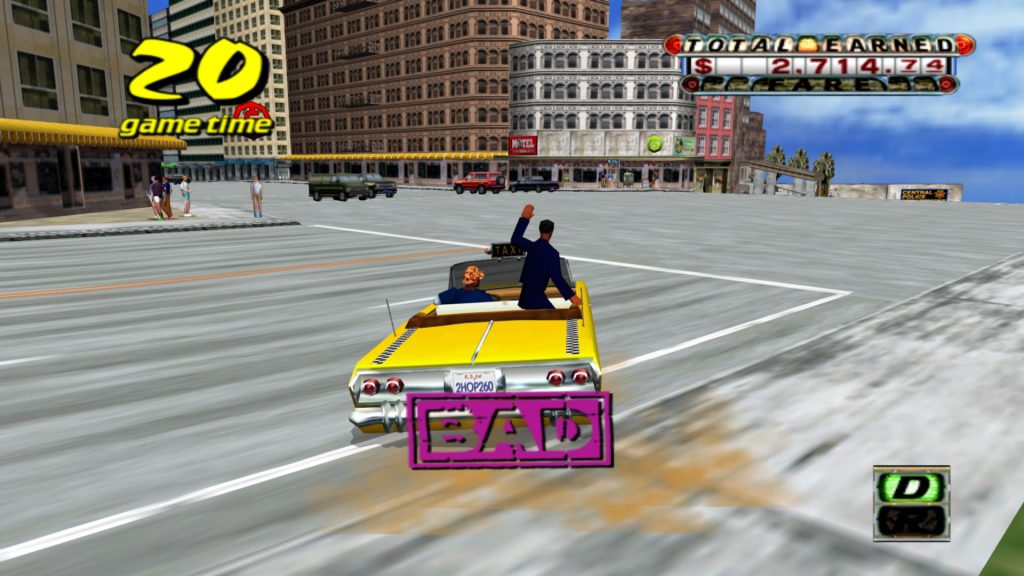
And on the same day, in the same CeX, what do I find on the shelves? Another distant memory, calling my name, for the low, low price of three quid – it’s Crazy Taxi. I didn’t even know it was on the PS2. All my memories of it came flooding back. I had to get the game.
I come home, back to my mediocre first year apartment, and get everything set up in the kitchen. And once I start playing, it’s just as clumsy – and just as fun – as I remember it being. Much to the annoyance of my flatmates, I play it constantly, with The Offspring singing on and on as I run into walls and drop off angry passengers.
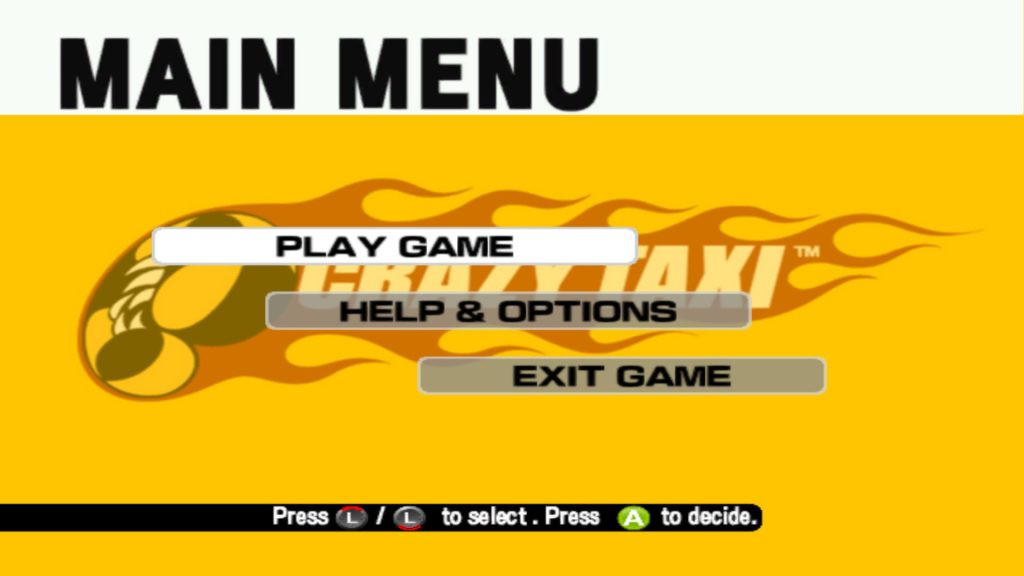
WHAT EVEN IS CRAZY TAXI?
So, Crazy Taxi. It was developed by SEGA’s Arcade division, AM3 – who later re-branded as “Hitmaker”, for whatever reason – during that awkward period when SEGA were branching out into a whole load of new IPs but were coming toward the end of their console efforts.
This meant Crazy Taxi had reach, though. It was initially made for the arcades in ’99, alongside a lot of other now more obscure SEGA machine titles AM3 also worked on. It was later released on the Dreamcast, and after SEGA called it quits on the DC, it was again ported to the GameCube, PS2, and the PC. Its’ sequels have been found all over the shop, landing on the XBox, the GBA, and the PSP.
Today, we’re not too interested in sequels – I’m more interested in doing a retrospective on the original, mostly because it’s the Crazy Taxi game I’m the most familiar with, and I’m just sort of nostalgic for it. I realise as I’m writing that this whole script is turning out to be very self-centered. It has also occurred to me that you might have never played Crazy Taxi before. So now that I’ve wasted a load of your time with a cumbersome crazy autobiography, let’s talk about the game.

Crazy Taxi is, well, what it says on the box. You choose one of four cab drivers to hurl around as, trying to bag as many fares as you can in the little time you’re given. The original ’99 arcade version is the most straight forward: “pick a car and driver!”, start with a bit of time on the clock, pick someone up, drop them off, then gain some extra time and money for doing that. Rinse and repeat until you run out of said time.
Upon finishing, you’ll get a score, which is how much money you made. Either everyone in Crazy Taxi world is insanely rich and you’re charging high rates in an attempt to fleece them, or there’s been a serious bout of hyperinflation which the crazy government is yet to get under control. Either way, a good score by the end of your cab stint is usually around four or five grand, but it is possible to get much more than this if you know what you’re doing.
You’re ranked on your performance at the end: if you do an absolutely terrible job, you’ll have your license revoked. If you do well enough, you’re certified as “CRAZY!”. Anything in between and you’ll likely get a grade, the worst being E and the best being an S.

Pretty simple, right? You go from A to B, ASAP, and hopefully, after a while, you’ll get an A. Or a B. Or an S, if you’re lucky. The formula was very addictive and it became a minor hit in the 2000s. Crazy Taxi’s arcade release did especially well in Japan, with its gameplay taking a significant and novel deviation from the usual arcade scoring formula.
The console release extended the hype to a variety of platforms and regions – Crazy Taxi sold like hot cakes on the Dreamcast, being one of the highest selling games on the entire platform. It was a hit again the year later on the PS2 and GameCube, with the former release reaching Platinum sales status in the UK.
When AM3 developed Crazy Taxi, they wanted to move away from the standard linear level designs of traditional arcade machines and make sure the game stood out amongst the others on offer. Most games rewarded players with high scores and constrained them to certain time limits, using life counters and predictable dodge sequences. Seeing that there weren’t many freedom loving, open world titles in the arcades, Crazy Taxi broke away from the old formula and opted to reward players with the good old traditional scoring system in the form of a monetary counter, but then also reward them with more playtime for speedy taxi-ing.
You couldn’t damage your cab, and you didn’t have a set route to follow – the whole game and your experience with it was more or less in your own hands. After a good few runs, you’d get a feel for the steering, the cabs, and the world around you, so you’d almost always get better each time you played – and it made you want to play again and again to play better and better. Players who were more conscious of good time management, the cabbies unique abilities, and the benefits of crazy stunts were rewarded with higher scores, making the game especially addictive for those willing to put in the extra effort.
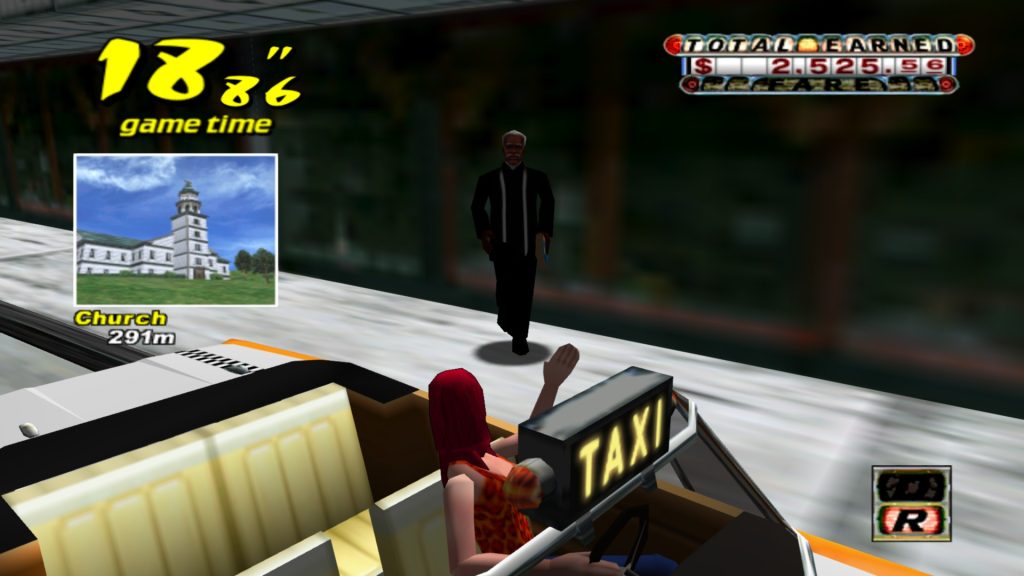
With there being so much to explore, there was added incentive to keep playing just to see what was around – you could find all sorts of new passengers in strange locations and see a couple of odd things if you stopped every once in a while.
It’s important to remember what sort of world Crazy Taxi was being born into; a game set in an open world was pretty new for the time, and very new in the arcade landscape. Other divisions of SEGA (namely the other arcade arm, AM2) were already working on innovative game mechanics within an open world setting in titles like Shenmue, one of it’s most expansive (and expensive) projects. This helped the other sub-studios become familiar with what were, at the time, great developments in video game history – SEGA was a real innovator in this regard.
AM3 took the mechanic of the open world during it’s early days and condensed it into a successful, profitable arcade game, truly fit for the time (meanwhile, Shenmue went largely unnoticed despite it’s hefty $70 million development price tag). Combined with it’s timer-scoring system, Crazy Taxi forged a unique experience no other machine could even compare to in ’99.

Another thing which certainly helped Crazy Taxi become such a big hit was it’s clean transition from the arcades to the home console. The Dreamcast’s specifications were based on the NAOMI board – the same hardware which hosted Crazy Taxi’s initial machine iterations – which made for a near seamless port.
Combined with the option to buy yourself a steering wheel for the DC, and you basically had the original arcade version in your house. Most of the ported versions of Crazy Taxi after it’s release on Dreamcast are relatively good because of this, despite the PS2 and GameCube releases technically being a port of a port. Such good porting (I need a synonym for port, I think) definitely helped boost the longevity of the first game, now often dubbed as a “lost time capsule” of the early 2000s.
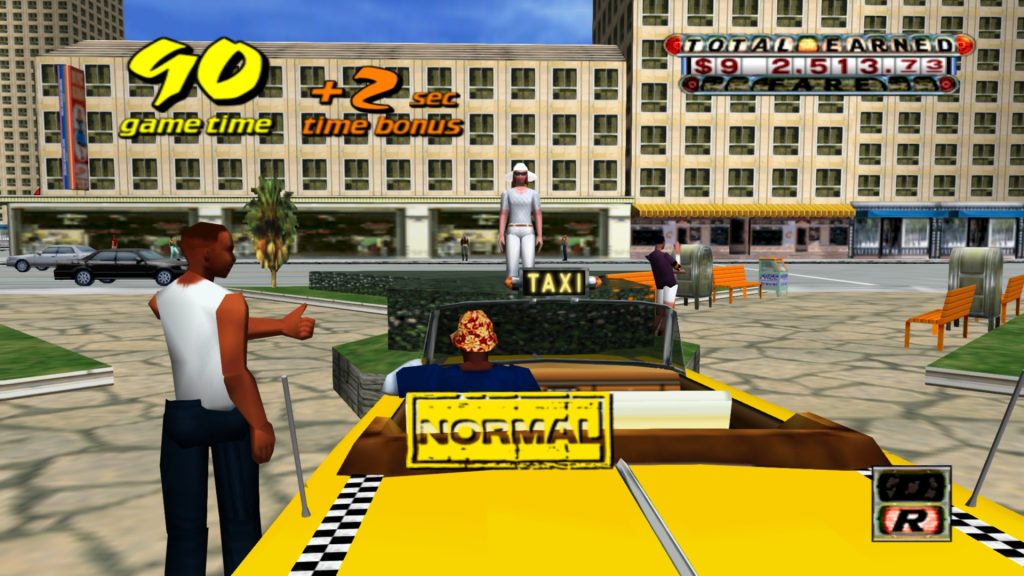
THE DRIVERS
Let’s talk about the drivers. The game won’t tell you this directly, but your choice of cabbie will make a difference to how you play. To sum them up briefly: Axel is the all-rounder, the run of the mill crazy cab type; B.D Joe is iconic, very fast, but handles poorly; Gena has the best acceleration; Gus’ car is basically a truck in disguise. If you’re new to the game, your best bet is choosing Axel or Gena. More experienced players can do well with any cabbie, but can benefit more than newcomers would from B.D Joe and Gus’ abilities.
The different attributes, strengths and weaknesses of the drivers aren’t described in any of the official manuals for Crazy Taxi. Bizarrely, there are full bios for each of them, alongside multiple pieces of artwork – even the meanings of their number plates are deconstructed – but there is no discussion of how they play in game.
The closest you get is on the back of the PS2 box which says they have “different style and attitude”, but this is only a very vague reference. So people have had to figure out the differences for themselves. However, thanks to whoever is responsible for the unofficial tips website “crazytaxi.net”, we have a pretty good idea of which cabbies are best for each scenario and play style.

Driving around in his Fourth Generation Cadillac Eldorado, Axel is the all-rounder, a safe pick from the bunch. In terms of personality, he has the most flair – but other than that, his driving is pretty basic. According to the manual, Axel is in a punk rock band, singing and playing bass guitar. He apparently thinks being a cabbie is good for his image and makes him look cool.
His number plate, “1NOM155”, means “I no miss” or “I don’t miss”, which is him trying to say “I don’t make mistakes” – although if you’ve played as Axel more than a couple of times, you know the moment he meets any traffic there will be plenty of opportunities for mistakes to be made. Perhaps he means to say he doesn’t miss the oncoming vehicles.
Combined with his light weight, Axel’s car width is a serious disadvantage. You’re gonna clip on-coming traffic, and you’re gonna be set off course by it. And that’s gonna happen often particularly on highways and the more metropolitan areas. Because of this, he’s especially prone to the dreaded ‘teleport bug’, where you can go flying up buildings and off the map completely, often spawning you back in an inopportune location.
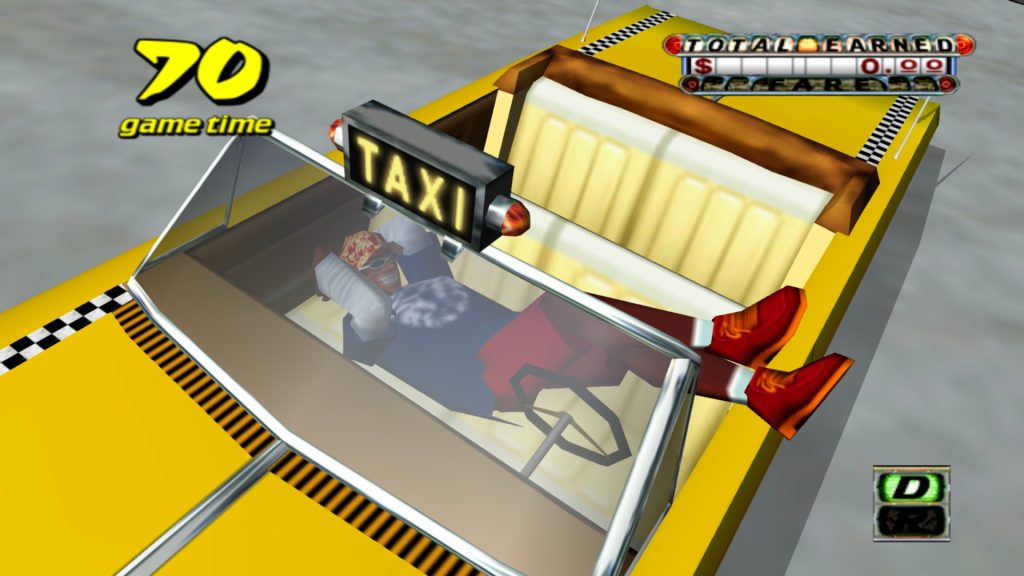
Arguably the most ‘crazy’ driver in his extremely wide Third Gen Chevvy Impala is B.D Joe, the fastest of the four. Just like the real life 60’s Impala, B.D seems to bounce an awful lot. Apparently, when he’s not a cab driver, he’s an entertainer – although I would say he’s kind of merging both professions into one. Watching someone play in Joe’s cab is always guaranteed to be an entertaining experience, if for no reason other than he’s going to be hitting everyone on the road and rushing around corners at breakneck speeds.
Personally, I like his handling and his attributes – but among the majority of players, he’s not so popular. You won’t see his cab in speedruns very often, with the meta not exactly in his favour. Strangely, he’s become one of the prime mascots for Crazy Taxi’s promotional material despite this. For me, he really completes the game. B.D Joe is the cherry on top, the pièce de résistance when it comes to making Crazy Taxi ‘crazy’. Not only is he completely unhinged, but his driving style forces you to go crazy, too.
Maybe I’m biased because I suck at drifting, yet it’s always easy to get a good drift in with B.D Joe. Some might say it’s a little too easy. Joe will often tell his more whingy passengers to “shut up! move yo’ butt!”, although his butt seems to be the one that moves the most. The butt of his car, that is. His Chevvy’s rear end will stick right out during his swift drifts, and more often than not it’ll catch something on the way. Make sure to move yo’ butt correctly, and try not to be a road hog when playing in Joe’s car.
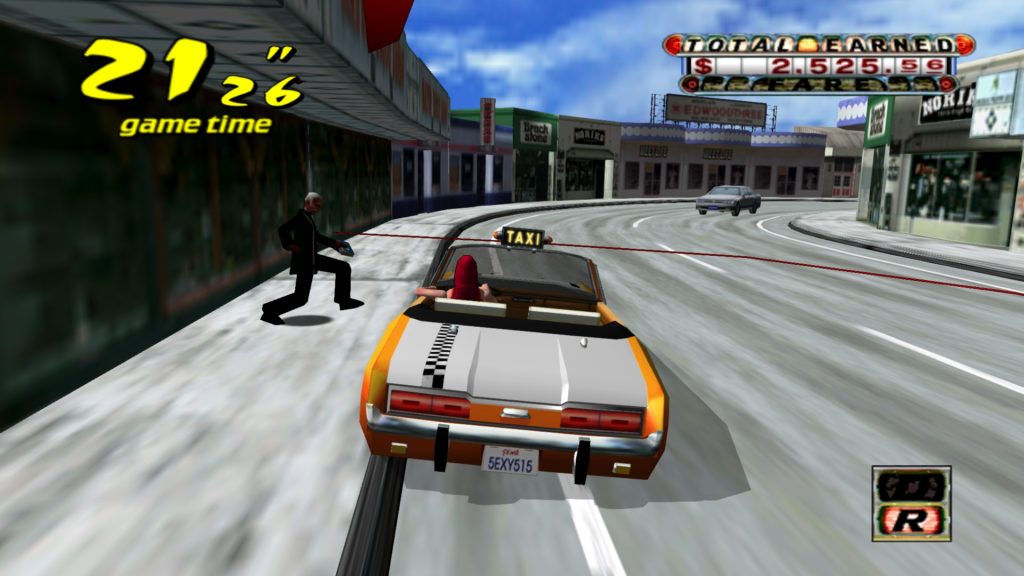
Apparently the only female cab driver in existence, driving a First Generation Ford Mustang, Gena is a pretty good pick for a CT newbie. Driving a common yet iconic and approachable car alongside her more relaxed personality compared to the other drivers, Gena’s whole image is made to attract the more conservative crazy types. If you’re not using too many special techniques, like drifts or dashes, you can still get around pretty quickly due to her fast acceleration, but her best driving will come out once you take advantage of all the crazy techniques you can master.
Her car is thin and highly responsive, with it’s driver having a very cool air about her. I’d almost say she was a little boring if she wasn’t so mysterious. Gena’s car is definitely the lightest and can be a little more prone to the teleport bug if a reckless driver decides to pick her – but her slim Mustang allows you to cut through most traffic with ease. And you will have to cut through it: so much as touch another car and you’re gonna be toast as the responsive handling combined with the light weight will spin you the other way around. If you’re more careful with her, you’ll do well.
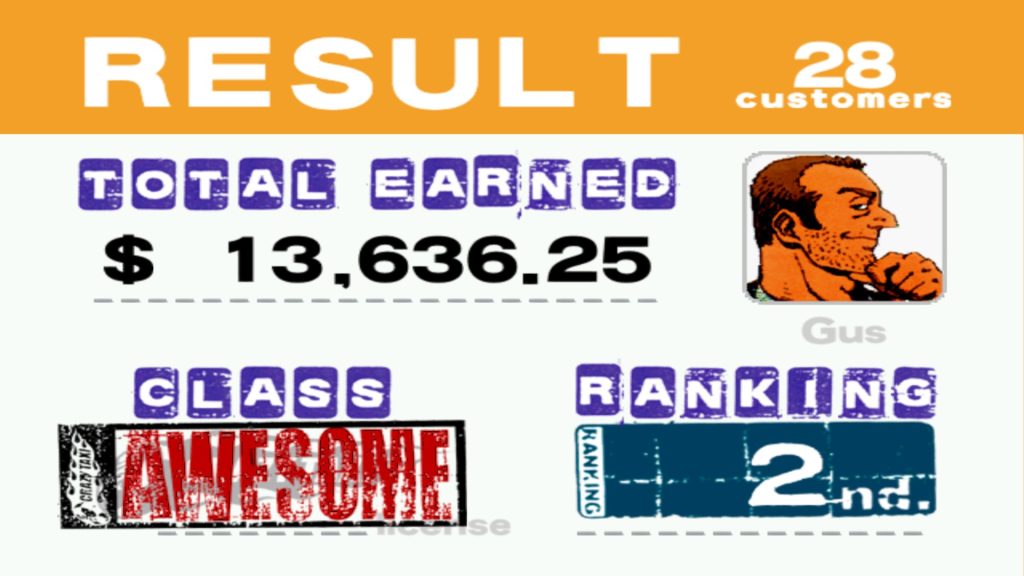
On the other hand, with Gus, the reverse seems to be true. In his convertible and very strong Third Gen Mercury Eight, nothing stands in Gus’ way. On-road, off-road, really really off-road, into oncoming traffic – his car will stop for nothing, and is by far the heaviest of the bunch.
Gus is an avid gambler – as you may be able to infer – and if you’re playing as him, it’s worth trying your luck every once in a while. Who cares if you hit that car, or take that corner a little wide, or end up on the grass, or in the subway. You’ll just push your way through usually.
But don’t chance your luck with absolutely everything – he’s not always the best at stopping or taking off, meaning you’ll probably lose quite a bit of time picking people up, and this can really affect your score before you get used to it. But once he gets some good momentum going, he’ll be racking up fares like he does chips at the poker table.

THE TECHNIQUES
Aside from hosting all the useful info on cabbie attributes, “crazytaxi.net” is also hosts plenty of info on Crazy Taxi techniques. However, those early Dreamcast players didn’t always have such an expansive internet to turn to in the early 2000s, nor did everyone have access to it. Back in the day, people had to learn things for themselves, so SEGA made a whole mode to help with that in the console versions: Crazy Box.
Getting good at this mode will help you really push the game to the limit. There are 9 regular Crazy Box levels, then 7 special levels you can unlock on top of that, each one of them teaching the player a new driving technique. Some of the levels are especially difficult to pull off and the later ones necessitate a combination of crazy moves that will take you a while to get right.
When you beat a few of those, then go back to playing the regular arcade iteration of Crazy Taxi, you’ll find yourself implementing new moves quite often. You’ll soon realise that you’re a lot better at the game than you were before. So now, you have a whole new component which helps perpetuate that positive feedback loop and has you playing more, with the hope that once you master Crazy Box you can master all of Crazy Taxi. For such a simple game with such a simple premise, it possesses some incredibly smart game design to keep players hooked.
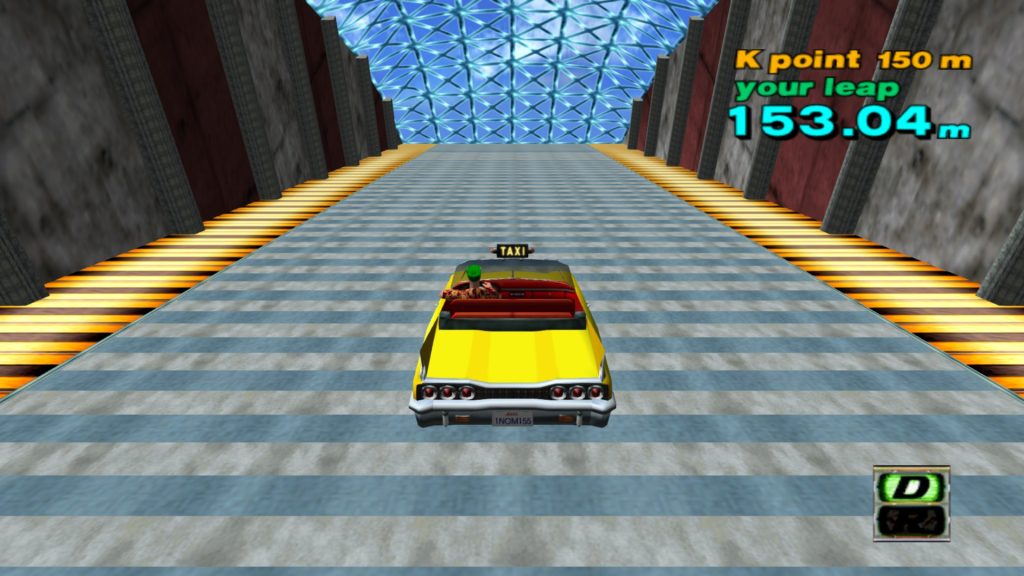
In the very first level of Crazy Box, you have the bizarre “Crazy Jump” course to complete. It’s in some sort of hangar turned liminal space. The objective: drive off a ramp and land 150 meters away from it. You can’t achieve this goal by just flooring it, though. You have to learn how to “Crazy Dash” , which involves pushing down drive gear and then hitting the accelerator right after. Timing is everything with learning this, and it takes a bit of getting used to, but once you nail the move you’ll be much speedier on take-offs and long drives.
Level 2-1 teaches you how to Crazy Drift, and gives you a relatively open area – plus an incredibly whiny customer – to help you perfect it. Level 3-1 teaches players how to perform a Crazy Drift Stop (of which there is even an “official” and an “unofficial” version, apparently).
The rest of the levels feature combinations of these moves or amp them up to the extreme, making sure you’re as precise and as efficient as possible with your crazy techniques. For this reason some of them are infuriatingly difficult, and there’s not much tangible payoff in completing Crazy Box other than – spoilers – unlocking the rickshaw. The real reward comes from getting much, much better at playing the main game, helping you hit super high scores in arcade mode with basically no sweat. Now that is a good feeling.
THE SPEEDRUNS
Of course, any game as fast and mental as Crazy Taxi needs to have a quality speedrunning division. And while it is a little limited, with it’s current speedrunning community being fairly small, the game is relatively well optimised. You might be wondering how runs for Crazy Taxi even work, given that the arcade mode has no set ending or clear route. For the runs recognised and verified on speedrun.net, instead of playing the main game, people compete to complete Crazy Box; you beat the whole thing on a new profile from start to finish in any order you like, as quickly as possible. You can switch between cabbies, you can use whatever tricks you want – including teleporting exploits – you just got to clear the whole thing, from start to finish, as quickly as you can.
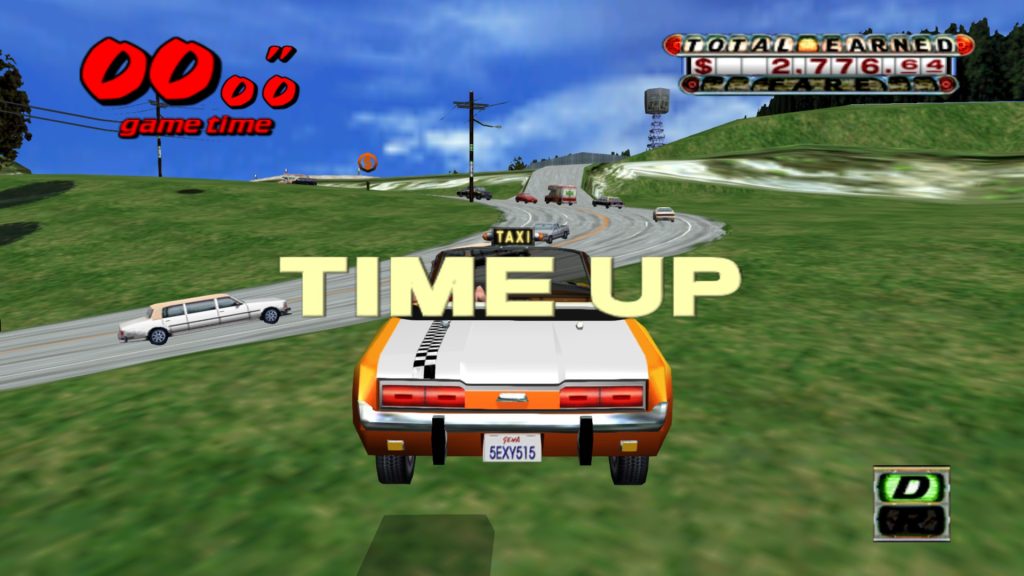
The long standing kings of running Crazy Taxi speedruns are Chuckles825 and 2dos. They run pretty much all the games in the franchise, and their records in CT1 of first and second places stood undefeated for years. 2dos ran all the levels as Gus, a good pick when it comes to beating levels with high density traffic, such as 3-2, S-2 and S-S.
For his first place run, Chuckles ran Gena, choosing sensitive and precise handling over brute force and weight. With her improved acceleration and responsive controls, Gena is great for levels with lots of passengers, lending herself well to levels with frequent stopping and starting such as 3-1, 3-3 and S-3. Apparently she’s also good at clipping and teleporting on 2-2, which is quite the time saver.
Newcomers are not unheard of on the scene, however. Also running Gus, RoboBowler managed to dethrone 2dos’ 2nd place run which had stood for around 8 years prior to their arrival. Starting out with the teleport on 2-2 first, it seems as though anyone gunning for the top spaces today might have to find a new meta to really bring the times down.
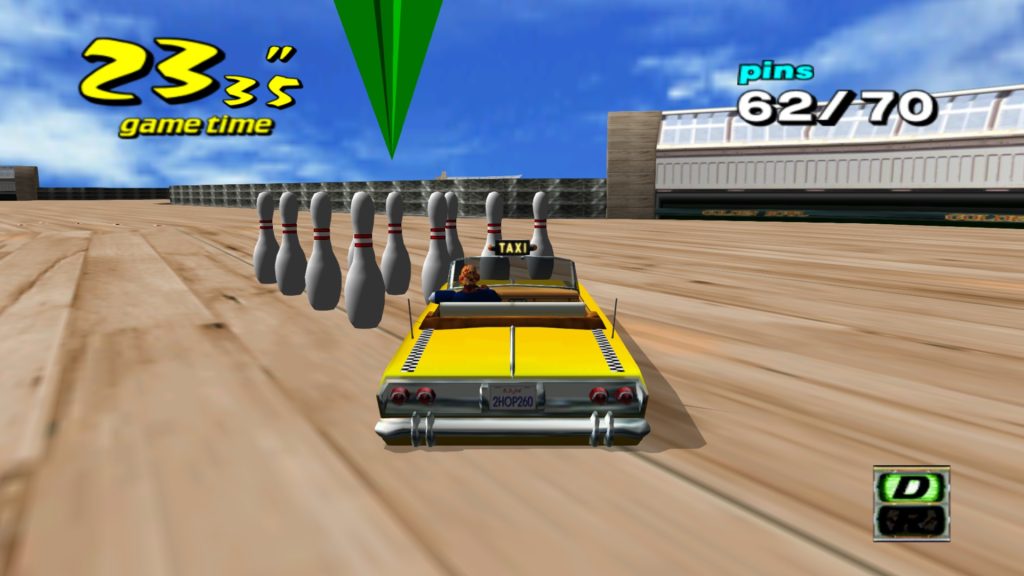
While changing cabbies between levels is permitted, it’s not a common strat used by many top runners since it takes up valuable time. This means drivers that are seen as worse in the general meta, like Axel and Joe, aren’t really run at all. That said, B.D Joe does lend himself quite well to levels which involve heavy drifting – particularly the bowling level, S-1 – due to his wide width and ease going into drifts.
There’s not much of a compelling reason to pick Axel for anything in particular, though. He’d be a good pick if you we’re having trouble getting quality drifts down as Gena, or having difficulty judging stopping distances as Gus – but you could just play either of those two more, get used to them, and optimise their attributes instead. Axel has nothing he’s really good at, and as a result has no attributes you can really abuse – if you want the best kind of results, he’s probably not your guy.
Crazy Taxi is lacking a little in the TAS department, sadly. The only real TAS that exists for the game was done by solarplex over 8 years ago, and this was not for Crazy Box – this was for Arcade Mode. The TAS gets the highest ranking – “CRAZY!!!” – as fast as possible without using any exploits, only faring 11 passengers in order to do so. This TAS is awesome to watch, and is really well set up. Hopefully, solarplex will return one day to do more for the Crazy Box levels – but I wouldn’t get your hopes up.
However, even without a TAS, higher scores in the main game have been achieved even more quickly due to various glitches, which murk the waters in terms of Arcade Mode speedruns. The most infamous of these exploits is the infinite reverse drift next to a passengers destination: if you keep moving near enough to a passengers final stop, the game will think you’re just close enough to be able to stop inside the box in time and will give you a grace period when your timer runs out rather than having passengers jump out of your cab. You can just abuse this by doing infinite drifts near the destination, which passengers will give you lots of money for. Forget 20 grand on 11 passengers – this way, you can do it on just the one.
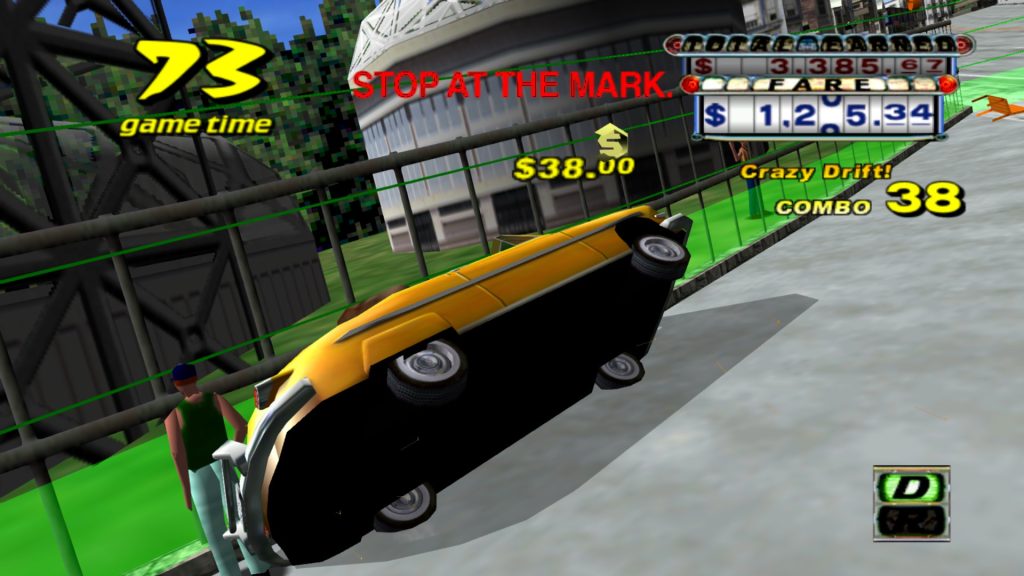
So this creates some denominational issues that are yet to be resolved for in the world of Crazy Taxi speedruns. What would solarplex’s run be categorised as? What differentiates it from the infinite drift exploits? What would the “end goal” or the “finish” be set as for Arcade Mode speedruns? Without a big enough CT community, these questions will probably never get real answers. For now, the parameters of Crazy Box are obvious enough to encourage the very occasional new runner to try and push the CT boundaries.
THE CLONES
Being one of SEGA’s more popular arcade titles, Crazy Taxi saw it’s fair share of sequels, both on the console and on a number of new machines. However, as fun as some of the new games are, the core gameplay mechanics in them are mostly the same and the franchise ran risk of becoming excessively stale with little new to offer.
The real nail in the coffin for the series came after its move to the mobile world. Two were released: City Rush in 2014, and a Tycoon game in 2017. Neither were really “crazy” other than in name. The latter game was literally just a tycoon and paid little if any homage to the original aside from aesthetics, and has since shut down. City Rush, on the other hand, is basically a Temple Run clone. There hasn’t been a proper console release since Crazy Taxi: Fare Wars, probably because SEGA has no clue as to how they might reinvigorate the series.

Crazy Taxi has since been relegated to the arcade textbooks, a game largely forgotten in the modern era. Despite that, it’s had a nice few homages in recent years: Fortnite did a fun little event called “Tilted Taxis”, which was pretty similar to Crazy Taxi if you ignore the ‘getting-out-of-your-cab-to-shoot-rival-taxi-drivers’ part.
There’s also Taxi Chaos, which is pretty much just a HD ripoff of Crazy Taxi which you can play on the Switch. It released to the tune of mixed reviews, and didn’t make much of an impact outside of it’s release month. I’ve never played it, but apparently it is just an inferior version of CT anyway.
A little while after, SEGA went on a copyright crusade against the devs – not their first crazy lawsuit, having already gone after The Simpsons: Road Rage – claiming they had essentially stolen and remastered their old concept. And as it turns out, there might be a good reason as to why they want to keep a tight hold on their old IP.
In May of 2020, a couple of interesting articles started making the rounds. During a financial results presentation, SEGA hinted at reviving multiple old franchises, most of them from the Dreamcast era. This obviously includes Crazy Taxi, but also some other Dreamcast classics like NiGHTS, Jet Set Radio and Space Channel 5. The vague plan for SEGA is to “remaster”, “remake” and “reboot” the older titles via HD redesigns, adding significant changes to the original gameplay.
At some point in the next 5 years, SEGA is looking to make some sort of “super game”, as they literally call it, involving many of their old IPs. The actual content behind this game isn’t described in detail, but they’re clearly looking to make something with scope as they aim for “lifetime sales of 100 billion yen”, which is roughly 900 million US dollars. It seems like reviving older assets could be a part of a build up to this larger title, but for now we’ll have to wait and see.

While I was writing this script, I actually struggled to find a proper arcade cabinet to play the game on. I had only played it on consoles before then – but eventually, I finally found a Crazy Taxi machine in the end. Several, actually. And for a first time playing on it, I’m not going to lie, it was weird. In the UK I can only seem to find the standing consoles, and they really do a number on your legs. It’s genuinely painful after a short while. But it runs very fluidly and graphically holds up to modern standards, even if it’s pretty difficult to control.
Most cabinets you find are going to have problems, though. Gear sticks often fail to function properly and the pedals can become easily jammed. Basically every monitor I’ve seen has suffered from screen burn where the “INSERT COIN” text is flashing, too. I find the remake, High Roller, is often more responsive than the original, and would recommend that if you have the choice.
Annoyingly I went all the way to London – then after failing, over to Manchester – for no good reason to try and find a cabinet. As it turns out, there is literally a standing machine in Barnsley which is about half an hour away from where I live. Ironically, I could’ve gotten a taxi there. I’m glad there’s one nearby, though, as I’ll definitely be back to play on it again.

For me, the search is over. My nostalgia craving is well and truly fulfilled, and my journey with this game is more or less complete. But what about your crazy journey? If you haven’t played this game yet, I implore you to do so. And if you’re a late 90s, early 2000s Gen-Z-er that grew up with it and just needed to pull it out of the back of your mind, equally, you need to go revisit it. This formula has stood the test of time, and it is a real joy to play.
…so what are you waiting for?
LETS GO MAKE SOME CRAZY MONEY
